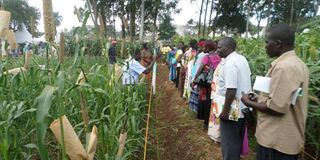Naro intensifies research on pearl millet for food security

Farmers on study tour of field trials on pearl millet at National Semi Arid Resources Research Institute in Serere District. PHOTO BY SIMON PETER EMWAMU
Crop scientists at Naro’s National Semi Arid Resources Research Institute (NaSaRRI) are at final stages of developing pearl millet, which could be the first resistant variety to Ergot, a disease that affects the growth of the crop and its yields.
Dr Geofrey Lubadde, one of the researchers, says the breakthrough on this will be a big boost for the semi-arid regions of northern and northeast Uganda where the crop has mainly been grown. It is also where other food crops meant to boost food security have seemingly failed to match the increased demand for food.
In Uganda, he notes, the crop has been grown widely for some years in the north (Kitgum, Lamwo, Agago), northeastern (Kaabong, Kotido and Abim), and eastern (Katakwi, Amuria, Kumi and Ngora) but the Ergot disease has hampered much of the yields.
Dr Lubadde adds that the initial research on the crop started at the same research centre in 1958.
It was then known as East Africa Agriculture and Forest Research Organisation (Eaafro), before it later stalled in the 1970s and 80s due to the lack of funds.
In 1958, germplasm was collected from farmers in Uganda, which served as good source of genes for developing improved varieties with wide adaptation in pearl millet growing regions in Africa (Botswana and Tanzania) and India.
“The resultant effect was that the gains registered were lost with more than 2,000 accessions of germplasm destroyed,” points out the lead breeder taking on the research to produce ergot resistant pearl millet explained.
Passionate to complete the 1958 research, Lubadde says the institute, found in Serere district resumed research activities on pearl millet in 2011 on a small scale, with focus on improving the crop to major constraints (ergot and rust diseases).
The activities started with conducting a participatory rural appraisal and some germplasm collection from pearl millet growing districts.
“The research resulted in identification of early maturing populations. To date, pearl millet improvement research is being done on a limited scale together with germplasm maintenance,” he reveals.
This research that is it is final stages prior to multiplication and distribution, according to Lubadde, is aimed at increasing food security in the northern and northeastern parts of Uganda, whose semi-arid weather conditions are suitable for the growth of pearl millet.
He notes that the variety grown in India, the male sterile Serere10LA was developed using some of the germplasm from Uganda while hybrid MBH110 was derived from parental lines developed at Serere using Ugandan germplasm.
According to the research, the crop unlike other cereals is rich in essential nutrients such as Vitamin B, Iron, potassium, magnesium, manganese, zinc and phosphorous.
Pearl millet is also good for people with type 2 diabetes and those with stomach ulcers due to being rich in magnesium.
“It helps to reduce cholesterol because due to phytic acid which increases cholesterol metabolism and stabilize the levels of cholesterol in the body.”
Lubadde says due to the health benefits of the crop there is high potential of pearl millet being a key ingredient in the food/confectionary industry through value addition.
Recipes for babies can be developed with pearl millet forming the bulk of baby food.
“It can also be used as a major component in the animal feed industry due to its high nutrient superiority and relatively low grain production cost,” he adds.
“This reduces the processing costs of animal feeds and thus increases the profitability.”
There is need to have pearl millet as one of the priority crops for semi-arid conditions in order to promote food and nutritional security, thus more funding is needed to scale up research activities on ergot and rust resistant pearl millet.




